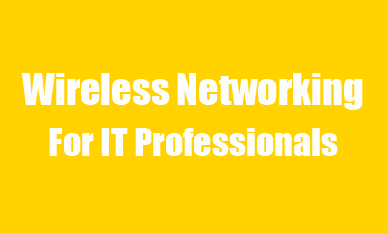
Day 1 – Plan and Design a Wireless Network
Learners will focus on understanding key aspects of the physical layer. Learners are introduced to spectrum analyzers and wireless network cards, and shown how to analyze and access the quality of the wireless medium and detect sources of interference. Learners will attain a solid understanding of why wireless and wired networks require different protocols and procedures in order to reliably transmit data over a wireless medium. At the end of day 1 learners will have a broad understanding of how to conduct a layer 1 site survey.
- Identify the unique challenges of transmitting data over a wireless medium
- List the major components of a radio
- Understand the impact of frequency on coverage
- Understand different antenna options, including MIMO and beamforming
- Use a spectrum analyzer to understand channels and channel bandwidth
- Use a spectrum analyzer to detect and analyze sources of interference
Day 2 – Configure and deploy a Wi-Fi network
Learners will learn how to configure a basic wireless network. Learners are introduced to the major configuration options on an Access Point and clients. They will understand how to find, connect, and send data over a Wi-Fi network. At the end of day 2, learners will understand how Wi-Fi works.
- Set up an open Wi-Fi network
- Use Wireshark to detect and analyze Wi-Fi packet flows
- Use Wireshark to analyze the impact of changing basic Wi-Fi settings
- Compare autonomous and centrally managed Access Points
- Distinguish between layer 2 and layer 3 roaming
- Contrast 802.11n high throughput and 802.11ac very high throughput
- Use Wireshark to analyze wireless and wired QoS settings
Day 3 — Configure and implement wireless security
Learners will be exposed to the most common wireless attacks and how to minimize the risk of these attacks. Learners will walk through the different Wi-Fi security configuration options including 802.1X, Pre-Shared Keys, Counter mode encryption with CBC-MAC, and AES.
- Configure and implement Wi-Fi authentication, encryption and message integrity
- Distinguish between wired and wireless security vulnerabilities
- Use Backtrack to execute wireless penetration test attacks
- Use packet and spectrum analyzers to identify wireless security attacks
- Understand wireless intrusion prevention mechanisms
Day 4 –Troubleshoot Wireless Networks
Learners will apply the knowledge and experience gained through the week in troubleshooting several difficult wireless problems. This last day is 100% hands-on based labs. These labs are designed to reinforce key learnings that relate to implementing and to troubleshoot the most common wireless network problems. Learners are encouraged to bring their own real-world deployment problems for analysis in the classroom. This section is entire lab and discussion based.
- Use spectrum analyzers to troubleshoot interference problems
- Use Wireshark to troubleshoot connectivity problems
- Use Wireshark to troubleshoot capacity and performance problems
- Use Wireshark to troubleshoot security issues
- Combine the results of spectrum and packet analyzers to identify different wireless network problems
- Analysis of real-world problems
Day 5 –Implement the latest Wi-Fi product enhancements
Learners will learn about the major enhancements to Wi-Fi products being rolled out by equipment vendors. Discussion will include the benefits to the enterprise and end-users, how these enhancements work, and implementation challenges. This knowledge will enable the learners to prepare and plan for upgrades to their wireless network. Learners successfully completing all the labs in this course are given a certification of completion.
- Understand the latest Wi-Fi technology, 802.11ax High Efficiency WLANs
- Discuss the implementation guidelines for Wi-Fi 6/6E deployments
- Provide insights into 802.11be Extremely High Throughput
The course has broad appeal to all IT professionals, including IT decision makers, architects, product management, and technical support staff.
The course does not require any prior wireless knowledge. However, learners must have rudimentary knowledge of IP networking as obtained in the Interface ICND1 course. CCNA level knowledge recommended but not required.
After completing this course, learners will be able to:
- Identify sources of interference and make recommendations to overcome interference problems
- Describe how Wi-Fi works and the different deployment options
- Identify and analyze Wi-Fi packets in Wireshark that are used for connecting and sending data
- Configure and deploy a wireless network
- Understand the benefits of Multi-User MIMO (MU-MIMO)
- Understand the different security parameters for different user groups, such as employees or guest access
- Identify and resolve common wireless connectivity problems
- Use packet and spectrum analyzers to identify and troubleshoot wireless connectivity, performance, and security problems
- Be familiar with major enhancements being introduced by Wi-Fi equipment vendors
